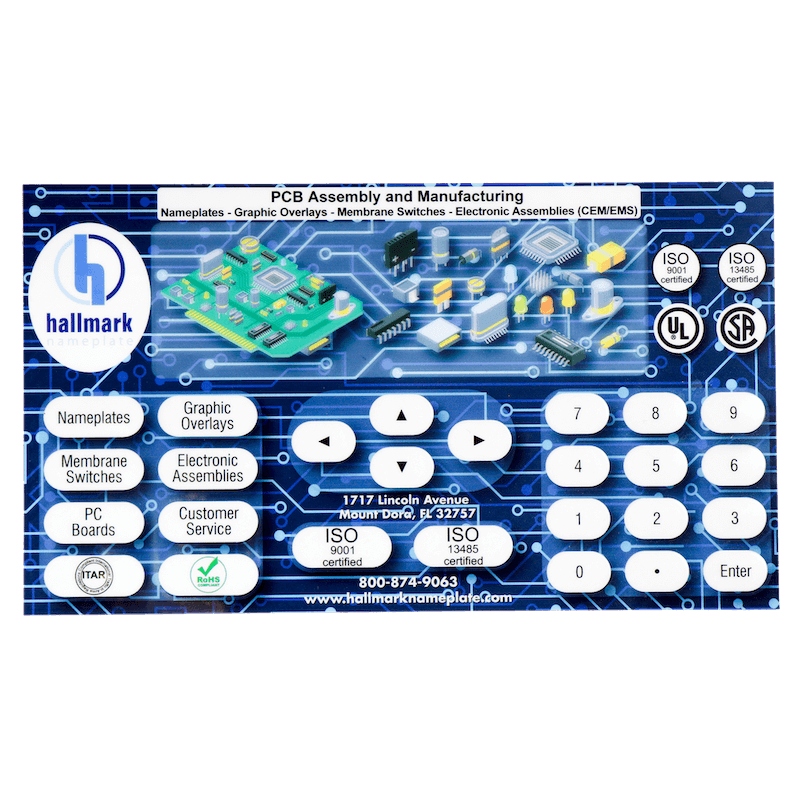Understanding Membrane Layer Switches: The Secret to Reputable and durable Controls

What Are Membrane Buttons?
Membrane layer switches are a sophisticated option in the realm of interface technology, integrating functionality and layout perfectly. These gadgets act as an interface in between customers and digital systems, integrating a number of parts right into a compact format. Normally created from flexible, thin layers of products, membrane layer switches are made to reply to touch, allowing users to communicate with machinery and electronic gadgets efficiently.
The main components of a membrane switch consist of a published circuit layer, graphic overlay, and a spacer layer that protects against unplanned activation. The graphic overlay can be tailored to show brand identification or customer preferences, enhancing looks while guaranteeing functionality. Membrane layer buttons are typically utilized in various applications, consisting of medical tools, consumer electronics, and commercial equipment, owing to their longevity and resistance to environmental aspects such as dampness and dirt.
Among the essential benefits of membrane switches is their capacity to withstand deterioration, making them suitable for high-traffic settings. Furthermore, they are lightweight and require marginal space, enabling for innovative styles in item growth. In general, membrane layer switches stand for a effective and practical selection for modern-day digital interfaces, weding innovation with user-centric layout concepts.
Exactly How Membrane Switches Over Job
The procedure of membrane switches joints on a basic yet reliable device that translates user input into electronic signals. When a customer presses the switch, the leading layer deforms, permitting a conductive element in the circuit layer to make call with a corresponding conductive pad on the underside of the visuals overlay.
The design of membrane layer buttons can differ, yet they typically integrate domes or tactile components to supply comments to the customer, enhancing the total experience - membrane switch. The products utilized in membrane layer switches, such as polyester or polycarbonate, add to their durability and resistance to ecological elements, consisting of moisture and dirt. The printed circuits are commonly enveloped, which shields them from wear and tear over time.
Benefits of Membrane Layer Switches

Furthermore, membrane layer switches are understood for their toughness. Constructed from durable products, they are immune to dirt, moisture, and physical wear, which significantly expands their lifespan contrasted to standard mechanical buttons. This durability makes them specifically suitable for high-traffic environments and applications requiring long life.
Another substantial benefit is the ease of cleaning and upkeep. The smooth surface of membrane switches lessens dirt accumulation and is frequently unsusceptible spills, making them perfect for setups that call for constant sanitization.
In addition, membrane layer switches use a streamlined profile, bring about a thinner layout that can be incorporated into various gadgets without including mass. This feature not only advice boosts the aesthetic charm yet additionally adds to an extra ergonomic product layout.
Applications of Membrane Switches
Straightforward and flexible, membrane buttons discover applications across a vast array of industries, consisting of medical devices, customer electronics, and commercial devices. In the medical area, these switches are essential to tools such as analysis tools, person tracking systems, and mixture pumps, where dependability Recommended Reading and simplicity of cleansing are important. Their ability to withstand extreme environments and keep performance makes them perfect for such applications.

In consumer electronic devices, membrane layer switches are made use of in products like microwaves, washing equipments, and remote controls - membrane switch. Their smooth layout allows for user-friendly interface, enhancing the general customer experience while offering longevity and resistance to tear and use
Commercial equipment also gains from membrane layer buttons, particularly in control panels for machinery and automation systems. These buttons offer security versus dirt and moisture, making sure regular efficiency in challenging environments. Their customizable attributes enable suppliers to customize them to details functional demands, enhancing efficiency and functionality.
Choosing the Right Membrane Switch
When selecting a membrane button, it is necessary to consider various factors that affect efficiency and viability for certain applications. The main considerations include environmental problems, responsive comments, toughness, and style specs.
First, evaluate the operating environment; buttons revealed to wetness, chemicals, or extreme temperatures call for details products to guarantee longevity and capability. Next off, assess the need for responsive comments. Depending on customer communication, some applications may benefit from a tactile reaction to verify activation, while others may choose a non-tactile design for aesthetic factors.
Toughness is one more essential factor; membrane layer switches ought to be developed to hold up against regular use, effects, and abrasion. Make certain the picked switch can endure the expected lifecycle, particularly in high-usage scenarios.

Final Thought
To conclude, membrane layer switches offer as right here necessary elements in the layout of sturdy and trustworthy control systems throughout different markets. Their portable style, incorporated with durable construction and adjustable attributes, enhances user communication while making sure long life sought after atmospheres. The versatility of membrane layer changes enables for customized solutions that fulfill details functional needs, reinforcing their importance in modern innovation. As markets continue to progress, the relevance of incorporating efficient membrane layer switch options can not be overstated.
Membrane changes stand for an important aspect of contemporary interface style, mixing capability with strength in different applications.Membrane layer switches are an advanced solution in the realm of user interface technology, incorporating performance and style perfectly. Normally constructed from versatile, slim layers of materials, membrane switches are made to respond to touch, enabling customers to communicate with equipment and electronic tools properly.
The style of membrane buttons can vary, yet they usually integrate domes or tactile components to offer responses to the customer, boosting the overall experience.In verdict, membrane changes offer as essential parts in the design of sturdy and reputable control systems throughout various sectors.